Wielecki’s to blame. Crystal clear skies, chilled turbo-friendly air, some of New South Wales’s tastiest curves just over yonder. And the MOTOR crew are stuck in a power station boardroom, enduring an OH&S seminar. The shooter wants artsy pics of our front-dragging turbo armada in front of two concrete towers, straight out of The Simpsons.
This feature was originally published in MOTOR’s October 2006 issue
Fine, says visitor chaperone Julie. But you’ll need stack hats. And goggles. And flouro vests. And, oh, take this induction exam. No pass, no pics. Cars parked. fresh fuel and rubber, the only thing burning is our patience. It quickly goes as pear-shaped as a school kid’s playlunch.
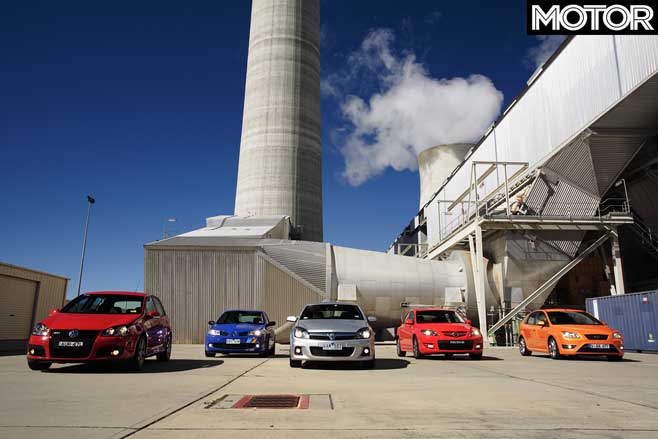
Cleary and I doodle on our questionnaires. Rohan daydreams, Wielecki experiments with blue-collar safety-gear fashion, and Colin and Ben nod off with mid-day siestas. But by some miracle, the village idiots are granted security passes. In full construction worker regalia, we make a hasty exit to the car park when someone – I won’t mention names, eh, Cleary? – busts into a campy disco strut, and we burst into an impromptu song. “It’s fun to stay at the Y…M…C…A!”
Then it hits me. Wielecki’s subconscious has tripped over an ideal metaphor for attitudes towards the modern hot hatch: enough grunt to power a city, but about as macho as the Village People.
And that would be wrong.
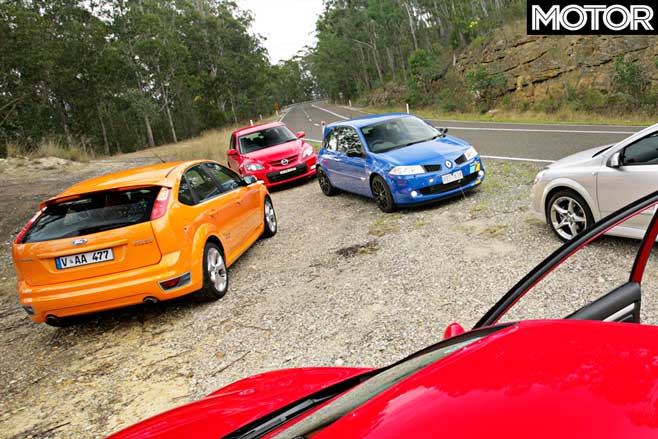
The turbo arse-dragger genre is three decades and a lightyear from its fledgling ‘70s roots. Cordia Turbo? Get over it. The pocket warheads present – Golf GTl, Mazda3 MPS, Focus XRS Turbo, Megane F1, and Astra SRi Turbo – have evolved beyond traditions of endless cogrowing, keeping gutless donks on the boil and manhandling featherweight gizmo-free tin boxes beyond meagre levels of grip. Dig around showrooms today and you might find a sub-$20k econobox offering such old-school joys. And each of the five here would maul it like a poodle thrown to pitbulls.
Today’s hot hatch benchmarks? Tractable, torquey, and flexible urge, spirited roadholding and heavyweight braking competence are pars for the twisty course. Punters want luxury, ride comfort, bells’n’whistles fruit, and active handling trickery, wrapped in hatchback dimensions. weight and sticker price. Understeer and torque-steer. that inherent wrong-wheel-drive foible? Get rid of it. or at least most of it. Impossible? That yardstick called Mk V Golf GTI proves otherwise.
GTI plaudits have been shouted from the mountaintops, ad nauseam, but it’s worth reiterating the Euro PCOTY podium finishers be-all, end-all asset: it simply doesn’t do anything badly. The giant-killer favours depth of balance over devastating prowess in select criterion. The consummate all-rounder? No doubt. An exceptional value and intelligent motoring purchase? Absolutely. The hottest front-drive turbo hatch on the block? Well. maybe…
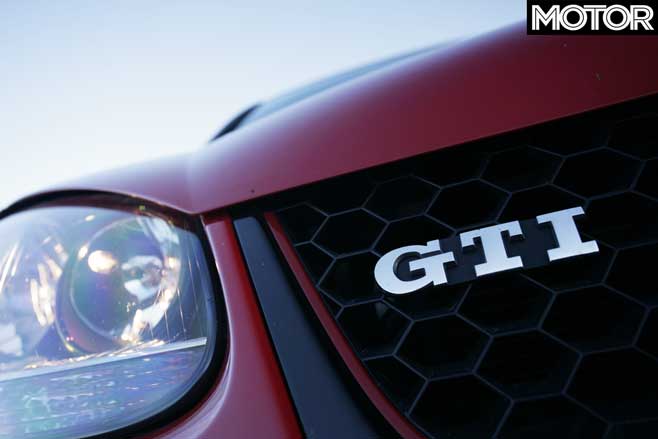
Cue Renault Sport Megane F1 and Mazda3 MPS, which have just moved into the neighbourhood, chests puffed out, and wielding sticks the size of goalposts.
Their stats look formidable enough. The Frenchie‘s 2.0-Iitre turbo donk pumps out 165kW and 300Nm – 18kW and 20Nm over the GTI – and, at 1361kg, it‘s three kilos lighter. The limited 30-only F1 is also $300 lighter on the hip pocket than the (DSG-equipped) Golf’s $42,290 ask. It’s got flair, too: aggro stance, black rims, Brembo stoppers, a throaty note, and war livery pegging F1 as Renault’s racy performance spearhead. Its three-door ‘French mullet’ body is much sexier than the boxy five-door models, and oozes enough character and sublime menace to send GTI packing to Nanna’s driveway.
MPS’s classier maturity doesn’t seem to raise the pulse as high, but just look at those vital signs. Packing a staggering 190kW and 380Nm – a full 100 Newtons up on GTI – even its portly 1403kg heft doesn’t stop the Japanese Jock from caning the F1 and GTI on power-to-weight. “Our quickest model,” says Mazda, and after belting MX-5 and ‘6 MPS in East-West PCOTY, and level-pegging WRX for 4th, we believe it.
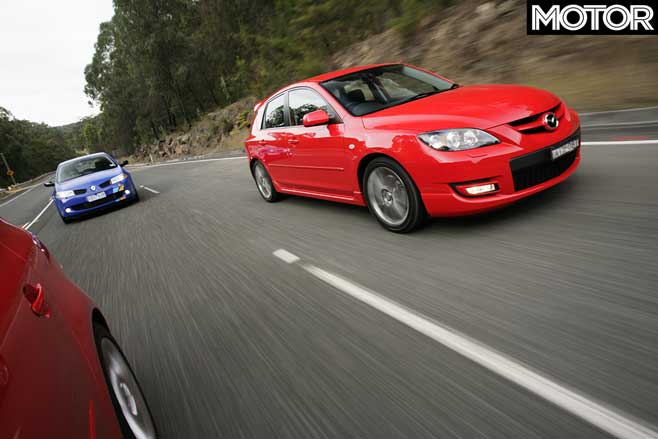
Against GTI, though, it’ll have to put bigger grunt down through 215mm hoops – the narrowest of the five – and channel energy in athletic ability at the first sniff of a comer. Our fruity-spec (optional) Sports Pack cops leather/Maztex fabric trim, Xenon headlights, glossy alloys and a 222W seven-speaker Bose stereo. At $43,690, it’s a little pricier than GTI, but not by much. Too bourgeois? At $39,990, the base model lineballs the manual GTI.
Keeping them honest is Focus XR5 Turbo. At 166kW and 320Nm, its Volvo-sourced 2.5-litre five-banger outgrunts everything bar the MPS, and yet it clocks in at a mere $35,990 in any colour you like other than look-at-me speedboat orange (an $1800 option).

The biggest mill and heftiest weight (1442kg) makes XR5 the muscle hatch of the five – even the ignition timing was tweaked at idle phase to add exhaust note beef. And, despite its UK development, German engineering and Swedish donk, there’s something oh-so dinky-di about the feel and presentation. Refined and agile, the XR5 earned kudos a couple of issues ago by taking it up to HSV’s pricier VXR.
Why no VXR? Well, 12 months and one prototype does not maketh a showroom contender. Instead, the Astra SRi Turbo gets the GM guernsey. At a sharp $35,350 – a whopping $8340 cheaper than MPS – Astra’s the underdog. But it only has to be four-fifths as hot as the sharp-enders to post a serious bang-for-bucks challenge. Considering SRi matches GTI for outright power, and concedes just 18Nm of torque and 37kg of weight, it looks well in the running.
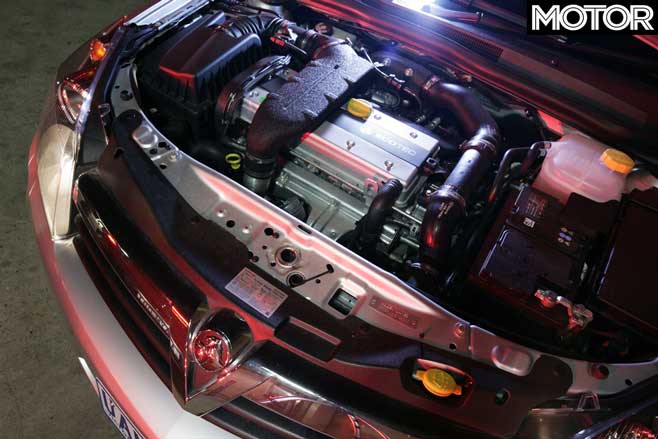
So let’s cut to the chase. Or. specifically, the Astra’s failure to sustain said chase. Two days, two vastly different road loops, a hundred corner varieties, five drivers to woo offered Astra every chance to shine. Somewhere. Somehow. But even before the Belgian-built hatch plunged its vague nose into the first curve, it was marking itself as the tail-gunner.
In isolation Astra shows promise, but in the company of these rivals, all glimmers of hope are extinguished. The four-banger‘s toey low-end tractability gives way to top-end lethargy. And that’s if you can manhandle the hellacious torquesteer through the chunky baseball bat tiller. The seats offer moderate comfort and support, but seem to be trimmed with the hide from a plastic cow. Crappy ‘edged’ switchgear? Poor rear vision? Flouncy shift action?
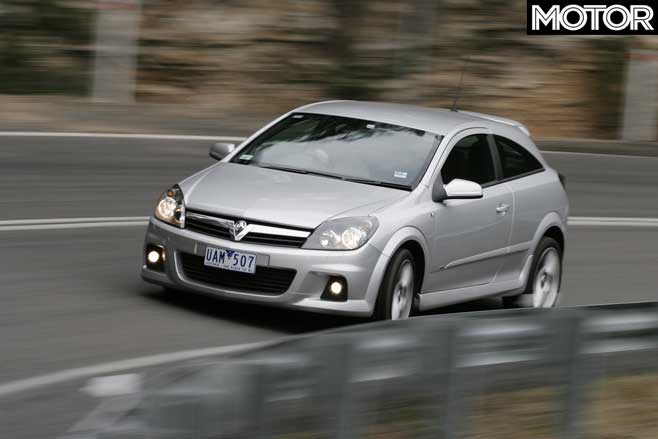
Redemption would come if a thoroughbred lurked within. Nope. Turn up the wick and the heaviest steerer is also the dullest pointer. Meagne front-end bite limits corner-entry attack, and when the nose starts to push like a lead torpedo it takes adventurous shoving to regaining trajectory. By then the others, including XR5, have bolted. Most defined at five-tenths, the SRi persistently underachieves.
XR5 is more promising. At a cruise, the Focus is all Jeckyl; as pliable and compliant as a grocery getter, with doughy low-rpm urge and slightly washy body control that requires tiller correction over fast sweeping undulations. Hauling its weight takes a windup from 80 clicks or so, but grab its scruff and XR5 taps its inner Hyde.
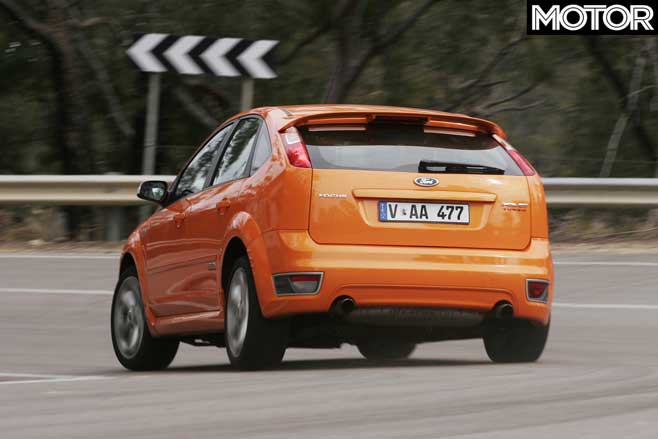
At four grand, the big-block 2.5 piles on a punchy slab of torque, the body control muscles flex and out comes a confident, light-on-its-feet demeanour. Push hard and it stays balanced, with a progressive grip breakaway and predictable control to rival the GTI. It’s a sheer bloody hoot. Still, it’s not overly planted nor sharp, failing to match Golf’s precision, or Megane’s front-end tenacity.
The F1 most desperately wants to be a go-kart, and lays on the boy-racer signals thick and, for the most part, convincingly. The taut chassis is fidgety and choppy, but decent damping means the chassis is more supple and composed over ruts and bumps than its stiff ride quality suggests. And, jeez, feel that grip. Its 235mm SportMaxxs provide the largest footprint of the bunch, and compared with XR5 you’d swear it’s on rails.
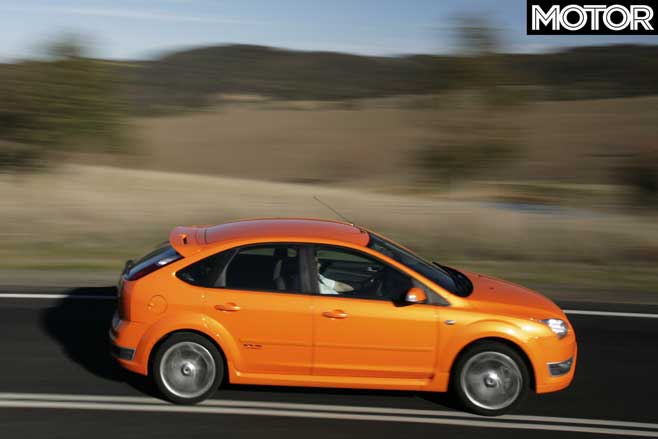
The mechanical grip advantage translates to spirited mid-corner speed, and there’s tonnes of bite for pinpoint nose placement. It’s just a pity the steering – the vastly improved Cup version that the F1 shares its underpinnings with – lacks detailed communication, and its variable resistance isn’t quite as speed-reliant as Renault’s boffins may claim.
However, add robust power delivery from the sweet revvy turbo four and F1 demands discretion. Push the friendship and roadholding breaks away and fast, especially in the tight stuff where Megane feels nose-heavy. Too hot with corner entry speed and it’s all tragic understeer. Sink the boot in too hard on corner exit and the nose wants to wander, plough, or head anywhere else but the chosen line once the unloaded front hoop cries freedom. Not good.
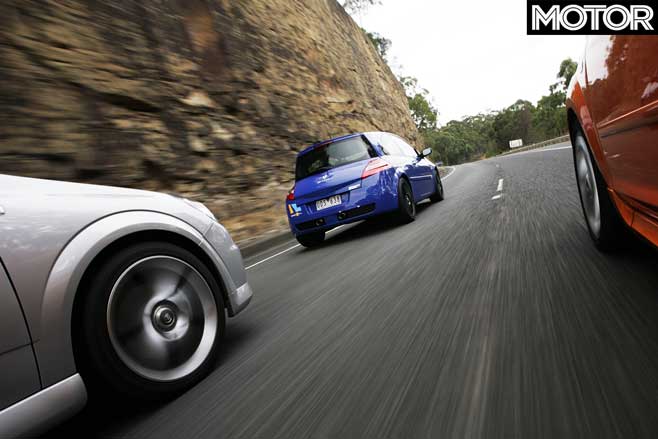
Neither is F1’s interior. Apparently, ADRs are to blame for the missing Recaro pews offered in Euro-spec F1s. The replacements offer decent support and comfort, but they appear to be trimmed by Baby-Co and are inferior in purpose to all bar the Astra’s.
XR5 does get pukka rib-hugging Recaros. But it’s not all rosy inside XR5, though. Plastics and finish tap into Falcon’s darkest side, the tiller is spongy, the seating is hunched. And I wonder if buyers receive a complimentary wetsuit after an eyeful of the extreme-sport orange fabric. XR5’s clutch is light underfoot. and shift quality is slightly doughy through the gates.
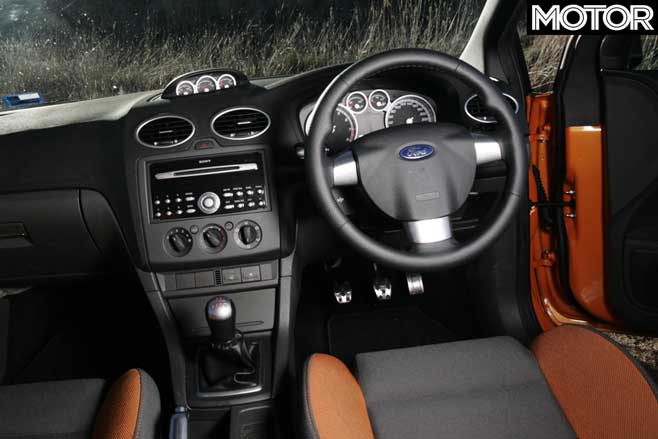
But, again, F1 loses out for driver interaction, with an overly sensitive brake pedal and vague gearbox that feels as positive as rowing a fork through cheese soufflé. On aggregates, it’d be easy to write off the F1 to a languishing fourth. That is until you unclip its leash and send it bolting along fast and flowing curves in search of German and Japanese blood.
Yes. MPS and GTI are the odd couple, but similarities extend beyond price. Parked. they’re the most austere of the group. Inside both are well-appointed, with solid build and a rich quality of tactile materials and finish levels you’d expect to pay $20k extra for.
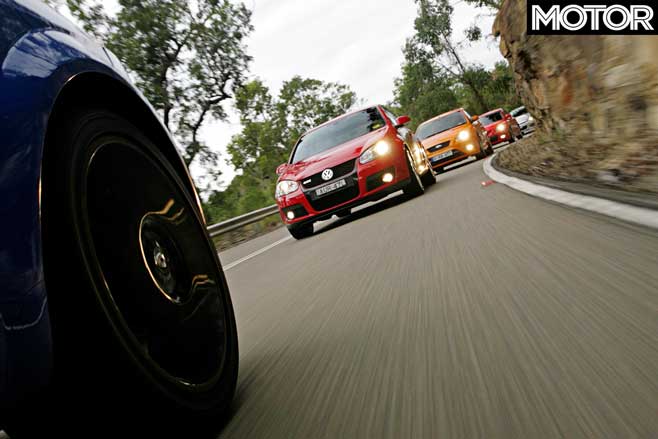
MPS pips Golf for driver positioning and alI-round ergonomics, its superb Recaro-wannabe pews slung low. GTI, though, has clearer vision, stylish teutonic presentation and to-die-for tiller with superb DSG paddles. But neither are perfect. MPS’s instrumentation looks stylish. but the speedo needle’s shallow arc to 100 clicks is annoying. Meanwhile, the Golf’s +/- shifter is arranged arse-backwards. So far, so even.
On the road. MPS and GTI are completely different animals. With its chipper turbo whistle, the Golf pulls strongly with a buzzy surge, the DSG pinching ratios with a buttery seamlessness. It’s impressive, and one of the smartest cog-swappers around, but left in D (for dumb) it’s easy to catch DSG snoozing if you trounce on the loud pedal mid-comer, resulting in a sudden torque dump once it mans the action stations.
The MPS’s armour chink is its clutch’s grabby take-up, requiring careful pedal metering to coerce smooth off-idle getaways. The steering’s weighty and positive, the ’box’s gates are gun-barrel tight, and the anchors bite with confidence. But the engine’s the eye-opener. Sink the boot and from two grand it’s an explosive rush of torque dynamite, complete with banshee howl of induction noise (or perhaps the sound of tread ripping from the tyres). Considering there’s 380 Newtons pumped through the fronts, MPS does an admirable job using some deft trickery to smother torquesteer down to a dull tiller tug.
Does MPS feel quick? Bloody oath it does. But whether MPS can effectively channel its extra grunt into pace and whether it’d be a better tool with, say, 20 less kilowatts and 50Nm less torque – is the key issue. The stopwatch suggests the package is on the money: MPS nails GTI to the standing ton by just over one second (6.61sec to 7.63sec) and nails 400 metres nine-10ths quicker (14.67sec to 15.45sec). Fine, but throw some curves into the equation?
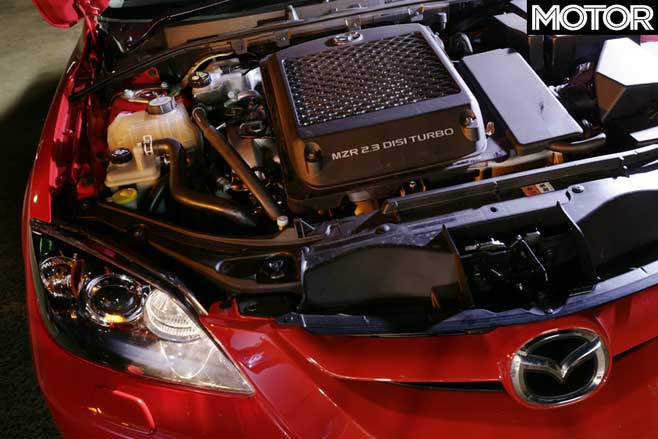
During their recent PCOTY tests, MPS dispatched Oran Park’s north circuit 1.7 seconds quicker (37.10sec to 38.84sec) than GTI. And that MPS weaves its fury on narrower tyres suggests its engine/chassis combo has reaI-world blacktop potential.
Throw it down a twisty pass and the GTl’s an exercise of consummate balance. Golf is most playful of the bunch. It moves around a bit, working the sidewalls of its 17s (the rest have 18s), but engagingly so, transferring its weight where grip and poise demands. It’s an understeerer, but what it lacks in F1-like bite it counters with stunningly incremental pin-point steering – the best of the bunch by far. So controllable, so predictable, GTI maximises its engine and chassis to full effect, without overkill.
It becomes really clear, very quickly. that MPS animalism requires more restraint when you’re up it. Thankfully its progressive throttle mapping and pedal throw allows easy metering of the turbomotor’s flexible, near inexhaustible Newtons. The six-speed’s ratios are sweetly spread, but its often more effective to grab 3rd or 4th and keep the tacho needle hovering around 3500rpm, and finesse the effortless tractability to milk sizzling road speed. Its mechanical LSD helps to limit wheelspin, but it could be tighter.
Even though it feels less lively at the front, MPS’s nose has good bite, cuts a confident line and is less punishing on its rubber than GTI. But that’s only half the story. With huge grunt and well-sorted nose throws, you can coerce a little torque-steer and allow those gentle tiller tugs to become useful communicators o! scrabbling traction and compromised acceleration – not unlike the way intimate tillers provide feedback of lost lateral grip – which helps throttle modulation. It’s an unusually effective technique. Get it right and MPS’s slingshot effect out of corners is exhilarating.
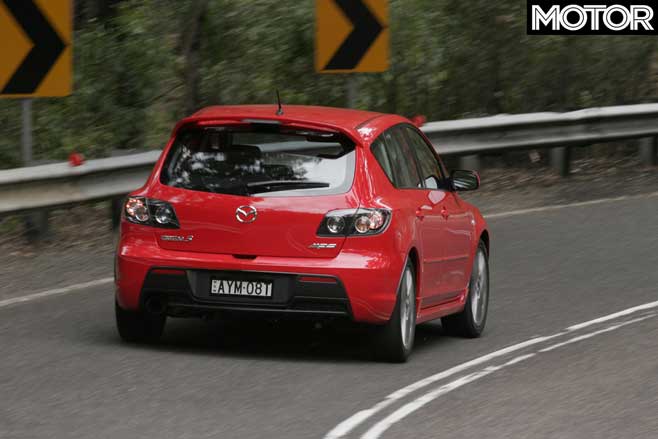
But it’s in the banzai corner-entry theatrics – trail-braking, IiIt-off oversteer – that sorts hot hatch mettle. And where Megane returns, waving Its boy racer stripes. Switch Its chassis smarts off, fire it into a bend under a trailing brake, and from Its flat stance, taut damping, and bitey rubber springs an edgy, dynamic competence. You can launch it in hard and deep and it leans on its nose firmly while hanging its tail out hard and fast, scrubbing speed off with its tyres, rally-style. It takes bravery, and tempered moderation applying those touchy Brembos.
And that’s also F1’s shortfall. At maximum attack, its demands on driver skill are higher,especially when trying to keep close company with the more user-friendly GTI and MPS. The Golf never wavers from its confidence-inspiring balance and poise. The Mazda, a sort of dynamic middle ground, is still more controllable, and also the most capable trail-braker of the lot. Au revoir, Megane.

With two such dynamically disparate rivals at such close quarters, deciding on the hottest hatch came down to a test of ultimate pace. One loop and two drivers, each swapping seats on back-to-back runs to eliminate driver skill from the equation. Japanese call it ‘touge’: nose-to-tail formation, with GTI leading and MPS trailing. Should the Golf pull away, it’d get the gong. Should MPS stick to GTl’s tail-pipes, each driver could gauge how much potential the Mazda kept in its reserves. The result was decisive: MPS was all over Golf like a rash.
GTI’s poise and undemanding nature means it often doesn’t feel as quick as it actually is. Such is its deception: Full noise is one thing. At merely a brisk seven-10ths, the GTI becomes a bit ho-hum, robbing it of ultimate fun factor. But as the most capable and satisfying punt for meagre driver skill, GTI retains its King All-Rounder crown. And is still, perhaps, the most pragmatic purchase. But it’s no longer the hottest hatch for all-out pace.

MPS is proved to be quicker, everywhere. For driver edification, MPS serves up lashings of fun factor anywhere above five-10ths. A worthy winner, if only by the tread of its skinny Bridgestone Potenzas.
Fast Facts
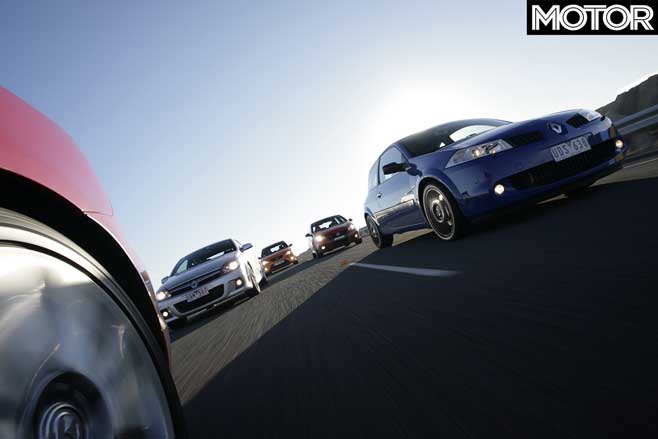
| u00a0 | Volkswagen Mk5 Golf GTI | Mazda3 MPS | Ford Focus XR5 | Renault Megane F1 | Holden Astra SRi |
| Body | 5-door hatch | 3-door hatch | |||
| Drive | front-wheel | ||||
| Engine | 2.0-litre, DOHC 16v, inline-4 turbo | 2.3-litre, DOHC 16v, inline-4 turbo | 2.5-litre, DOHC 20v, inline-5 turbo | 2.0-litre, DOHC 16v, inline-4 turbo | 2.0-litre, DOHC 16v, inline-4 turbo |
| Power | 147kW @ 5100rpm | 190kW @ 5000rpm | 166kW @ 6000rpm | 165kW @ 5500rpm | 147kW @ 5400rpm |
| Torque | 280Nm @ 1800rpm | 380Nm @ 3000rpm | 320Nm @ 1600rpm | 300Nm @ 3000rpm | 262Nm @ 4200rpm |
| Power/Weight | 110kW/tonne | 135kW/tonne | 115kW/tonne | 125kW/tonne | 105kW/tonne |
| Transmission | 6-speed dual-clutch | 6-speed manual | |||
| Weight | 1340kg | 1403kg | 1442kg | 1325kg | 1401kg |
| 0-100km/h | 7.36sec | 6.61sec | 7.50sec | 7.11sec | 7.50sec |
| 0-400m | 15.28sec @ 153.8km/h | 14.67sec @ 157.9km/h | 15.38sec @ 152.7km/h | 15.08sec @ 154.6km/h | 15.32sec @ 153.3km/h |
| Suspension (f) | MacPherson Strut | ||||
| Suspension (r) | Multi-linku00a0 | Control Blade multi-linku00a0 | u00a0H-style rear axle | u00a0Torsion beam, twin trailing arm | |
| Brakes (f) | u00a0312mm ventilated discs | 320mm ventilated discsu00a0 | 320mm ventilated discsu00a0u00a0 | u00a0312mm ventilated discs | u00a0308mmu00a0 ventilated discs |
| Brakes (r) | 286mm solid discsu00a0 | u00a0300mm ventilated discsu00a0 | 280mm solid discsu00a0u00a0 | u00a0300mm solid discsu00a0 | 264mm solid discs |
| Tyre Sizes | 225/45 R17 (f & r) | 215/45 R18 (f & r) | 225/40 R18 (f & r) | 235/40 R18 (f & r) | 225/40 R18 (f & r) |
| Tyres | u00a0Continental ContiSportContact2 | Bridgestone Potenza 050Au00a0 | Continental ContiSportContact2u00a0 | Michelin SP Sport Maxxu00a0 | Dunlop SP Sportu00a0 |
| Price | $39,990 ($42,290 as tested) | $39,990 ($43,690 as tested) | $35,990 ($37,790 as tested) | $41,990 | $34,990 ($35,350 as tested) |
Focus XR5’s Trick Steering
Sure, XR5’s uprated suspension – some 30 per cent firmer spring rates, retuned dampers, five per cent stiffer anti-roll bars – could be easily parts-binned from the aftermarket. But mega Focus (developed by the UK-based Ford TeamRS) has some nifty engineering tricks up its sleeve. Built using a stiffer shell, the XR5 uses a variable-ratio rack-and-pinion steering system that’s eight per cent faster than regular Focus models, and features a computer-controlled electric steering pump with three map settings – comfort, normal and sporty – which the driver can adjust from trip computer stalk.
Torque-Taming the Mazda3 MPS
For MPS, Mazda engineers went the hard yards to smother torque steer. Driveshafts angles and stiffness were matched, and a new torque-sensing mechanical LSD was developed which uses a 66:34 variable torque split. A torque management system was also introduced, which electronically alters both throttle valve position and the turbo’s wastegate valve to smooth out potential torque peaks in first gear, and operates in conjunction with a steering angle sensor when cornering hard in first and second gears.
Refined Renault
The lighter three-door F1 shares underpinnings with the five-door Cup, on which Renault introduced a rash of fixes to fix the wallowy Megane RS 225 in 2005. Damper, anti-roll bar and spring rates increased (25 per cent front, 77 rear), and Brembo stoppers with a larger master cylinder bore (25.4mm) were introduced, and the EBA was deleted to reduce its nasty ‘brick wall’ touchiness in the braking department. Cup and F1 also get a sleeved-tube steering column to transmit better tiller feel. Renault Sport and Dunlop jointly developed the silicon-based 235mm-wide SportMaxx rubber specifically for the Cup.
Acronyms that Work!
Blessed with exceptional natural balance and core engineering, the GTl’s prowess is largely down to conventional electronics smarts and their dodgy three-letter acronyms: ABS, EBD, ESP, and ASR, or Anti-Slip Regulation – in other words, torque reduction-type traction control. That said, it shines in the systems’ tunings, all of which seem performance-centric, and none of which are overly intrusive. GTI’s king gizmo is its DSG gearbox: two gear sets, two wet multi-plate clutches, and rapid-fire gear-changes all at three to four 100ths of a second.






